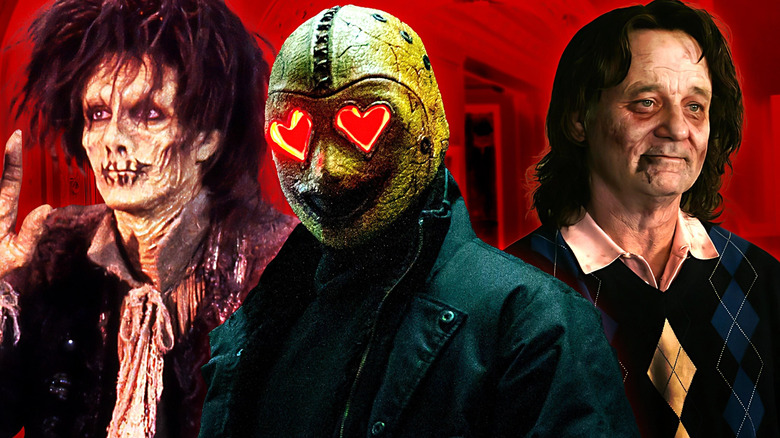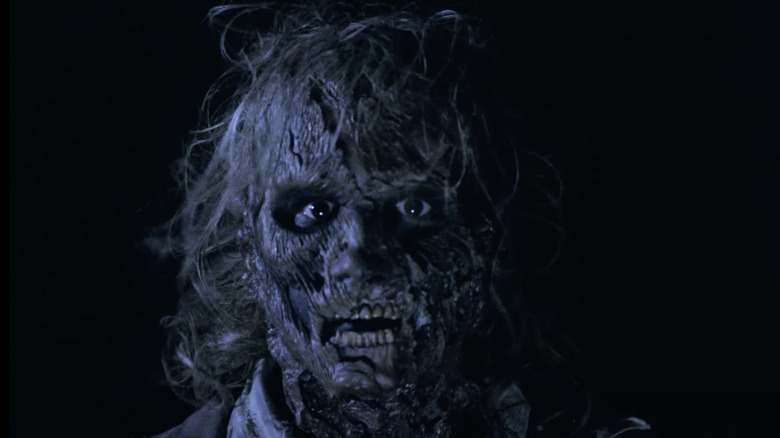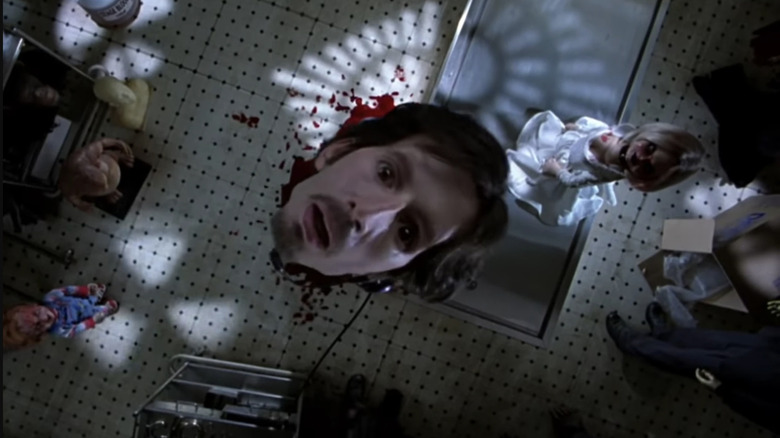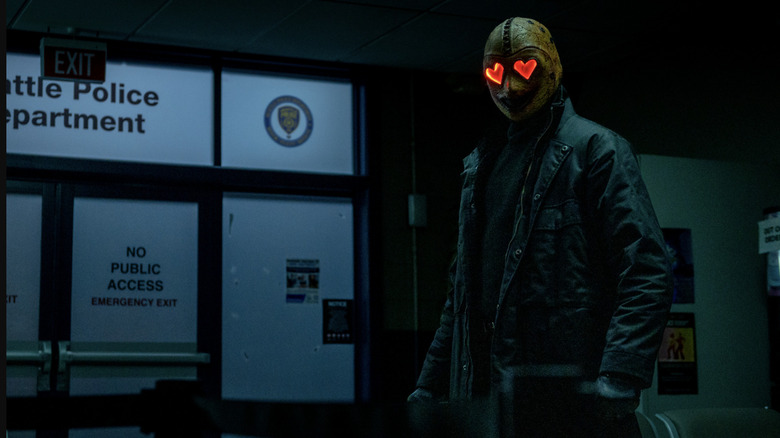SlashFilm: One Unsung Genius Created The Gnarliest Designs In Your Favorite Horror Movies
One Unsung Genius Created The Gnarliest Designs In Your Favorite Horror Movies

BY BJ COLANGELO
FEB. 7, 2025 7:00 PM EST
When it comes to slasher films, the iconography of the killer is often more important than the story. As long as fans are being given the chance to watch Michael Myers show up in his white-painted Captain Kirk finest to slaughter anyone who gets in his way, no one cares about trying to make sense of the the nonsensical and convoluted timeline of the “Halloween” franchise. Even people who have never watched a horror movie in their life could probably identify Jason Voorhees from “Friday the 13th” in his iconic hockey mask, or clock Leatherface from “The Texas Chain Saw Massacre” even without his titular weapon. The look of a slasher villain should strike fear into the hearts of the audience … but it should also be memorable enough to be marketable.
It’s a delicate balance, and it’s not the easiest thing in the world to pull off. The basic “sackhead” look of Jason in “Friday the 13th Part II” is only memorable because it’s Jason, because when the design first emerged five years earlier in “The Town That Dreaded Sundown,” it didn’t hit with audiences. (It also didn’t hit when the film got a metafictional sequel in 2014, because the slasher was just … a guy in a sack mask). Even a “bad” slasher mask can still be memorable (I still love you, Fencing Mask in “Urban Legend: Final Cut), but if you want your killer to pack a punch, you gotta call in the experts.
One of the best in the business is Tony Gardner, whose design for the new Valentine’s Day slasher film “Heart Eyes” (read our review here) is already being hailed as one of the best slasher villain designs in years. This shouldn’t be surprising, considering Gardner has one of the most impressive genre film pedigrees of anyone working today in the makeup and special effects field.
Tony Gardner got his start on the biggest music video, ever

Epic Records
Before we move forward, it has to be noted that Tony Gardner has a wild origin story. As he discussed on The Flesh and Blood and Bone Podcast he co-hosts with his daughter, filmmaker Kyra Gardner (who we interviewed for her documentary “Living with Chucky”), the way Tony Gardner broke into the industry doesn’t really exist anymore. He grew up around Cleveland, Ohio, and became fascinated with special effects and creature designs. He made facehuggers and an E.T. mask in his spare time, as just a few examples, before moving to Los Angeles to go to college. Once in Los Angeles, he decided to use his position as a student to get him closer to his heroes like Steven Spielberg and effects artists Carlo Rambaldi and Rick Baker. He got himself onto the Universal lot by taking a page out of Spielberg’s book by dressing up, showing up, and acting important but the way he met Rick Baker would get someone put on a watch list if replicated today.
The at-the-time college student knew where Baker’s shop was, so Gardner drove to the city and looked up all of the people named “Rick Baker” in the phone book, wanting to interview him for a school project (that didn’t actually exist). He eventually found himself on Baker’s doorstep, but he was out of town shooting a movie so Gardner spoke with Baker’s father, and left him slides of his amateur effects work. Eventually, Rick Baker contacted Gardner and agreed to be interviewed. They spoke for hours and the interview became conversational, but nothing really came from it. However later that summer after 18-year-old Gardner had returned home to Ohio between semesters, Baker tracked Gardner down and called his family home to offer him a job on a music video set requiring a bunch of zombies. This way, Gardner would know if this was the industry meant for him. He eagerly agreed and was on a plane the next day to return to Los Angeles.
That music video was Michael Jackson’s “Thriller,” arguably the greatest music video of all time.
Tony Gardner is a living special effects legend

Rogue Pictures
Listening to Tony Gardner discuss his career with his daughter Kyra on their podcast is surreal at times because there’s a humble casualness to name-dropping projects like “Return of the Living Dead,” “Army of Darkness,” “Hocus Pocus,” “Hell Fest,” “Freaky,” “The Addams Family,” “Freaked,” “The Blob,” the “Zombieland” films, and the “Chucky” franchise. Gardner is so intrinsic to the latter, that he even plays a fictionalized version of himself in the faux-movie within a movie “Chucky Goes Psycho” in “Seed of Chucky,” and is killed on screen by the very puppet he’s been operating for over a decade. These titles alone are enough to put him in god-tier status, but Gardner’s work isn’t exclusive to the world of horror.
He’s also worked on films like “Honey I Shrunk the Kids,” “Ace Ventura: When Nature Calls,” “Happy Gilmore,” and “Batman & Robin,” not to mention the bodily transformations shown in “Shallow Hal,” “Hairspray,” the “Jackass” films, and “Beastly.” He’s also prolific in the world of commercials, creating the designs for the Geico Cavemen (and subsequent TV show I’m sure you forgot existed) and the delightfully weird Halloween Snickers commercial featuring the rubber-faced woman at the grocery store.
But the one that always knocks me back is knowing that he helped create the signature helmets for Daft Punk, as well as the absolutely cursed [complimentary], skinless robot for their “Technologic” music video (which is a “Seed of Chucky” animatronic repurposed to give me, specifically even more nightmares). His Alterian Inc. company has solidified itself as an industry leader in prosthetic makeup effects, animatronic design, and specialty prop creation, not to mention his growing roster of slasher masks.
The Heart Eyes mask is horror perfection

Sony Pictures Releasing
When it came time to create the Heart Eyes mask, Gardner and Bryan Christensen took the ideas from the film’s creative team and brought it all to life. The visible seams and exterior laces elicit both a BDSM-inspired gimp mask and that of “The Collector,” with a fabric choice that feels reminiscent of Dr. Decker in “Nightbreed,” the tanned flesh of Leatherface, and yes, even Sackhead Jason. It’s an incredibly classic approach to a mask but injected with the contemporary iconography of the heart eyes emoji, glowing brightly to evoke the ominous threat of red lighting or the emphasis of attention like a Tex Avery wolf admiring from a distance. The eyes are also bespoke, providing the killer the advantage of night-vision, a sexier take previously seen by Buffalo Bill in “The Silence of the Lambs.”
The mouth is, of course, carved into a Glasgow smile, a grotesque twist on the universally accepted presentation of happiness. Combined together, the Heart Eyes mask is truly unforgettable. During a recent Reddit AMA, “Heart Eyes” director Josh Ruben talked about the collaborative effort that went into the mask’s design, between Gardner, Christensen, and the team at Alterian turning ideas into a tangible reality, to the VFX team in New Zealand led by Stef Knight who applied a Vaseline-esque sheen to the mask so that even in the dark, “the slightest light is picked up and refracted in an eerie, sweat-like way.”
When looking at the mask for “Heart Eyes,” we’re not just seeing a cool slasher villain, we’re seeing the culmination of over 40 years of expertise and horror history brought into a single design through creative collaboration, led by an industry genius.
“Heart Eyes” is now playing in theaters everywhere.
Read More: https://www.slashfilm.com/1783247/heart-eyes-mask-creator-horror-movies/
WE LIVE ENTERTAINMENT: ‘Freaky’ Interview with SFX Makeup Artist Tony Gardner
‘Freaky’ Interview with SFX Makeup Artist Tony Gardner
Leave it to Christopher Landon to bring horror and comedy together in a fun and inventive way. While starting his career with Burning Palms and in the Paranormal Activity franchise, the director has moved in a creative direction with both Happy Death Day and Happy Death Day 2U. As entertaining as those features happened to be, his recent slasher entry Freaky is easily one of my favorite genre flicks from last year. Sure it has a bit of heart and a ton of humor like Happy Death Day, but this time, the gore is blood red and ready to run. Thankfully, Mr. Landon had the incredibly talented SFX Makeup Artist, Tony Gardner, to bring in the gruesome goodness.
With a wild and varied resume, Mr. Gardner has been involved with everything from Hocus Pocus to The Blob (1988) to Jackass 3D and Bad Grandpa to Seed of Chucky and so much more. Not only is this man a major talent in the world of visual makeup effects, but he’s also one hell of a nice guy. With the Blu-Ray release of Freaky, we here at We Live Entertainment had the opportunity to chat with Tony about the incredible and inspired sequences that involved Vince Vaughn and Kathryn Newton getting… well, Freaky. Make sure you pick this blast of a horror experience up for yet another watch, and here’s looking forward to what comes next for Tony Gardner and the movie magic he creates.
I re-watched Freaky again. I think I’ve seen it about three or four times. I grew up loving slasher movies and especially the 80’s horror. And I know Christopher Landon has a seemingly very big, big heart for that period in time. When he approached you about creating the look and the actual gore sequences for Freaky, what were his first ideas? And how did you guys come up with some of these amazing kills?
What was his first idea? Well, his first idea, I think, was that he wanted to take it as far as he possibly could and have some fun with it, knowing that the comedy would diffuse some of the graphic nature. So why not push the envelope and then back away from that as needed in post-production.
With Freaky, you start off with the right kill. Could you talk about creating the wine bottle effect? That is just gruesome as hell, and it makes me grab my neck every time.
Well, I thought it was cool that Chris wanted to show how evil the killer was right off the bat and give you a context to know how horrible he was. Not just tell a backstory, but show it. So in showing it, the decision was to try and come up with, one, things people hadn’t seen before, and that was really all Chris’s theory. But two different ways to bring that about. And what’s nice working in today’s day and age is it’s fun to have the digital world to play in, which is great. But what was really fun with this was everything that we did was old school. And that made it just that much more fun for us because you had to pull this stuff up practically on staff. Chris’s idea with the wine bottle down this road just turned into a question of what is the best way to show the graphic nature of it?
We do sound effects to take it really far, as is usual on a horror film. But how can we get a couple of really graphic images that literally stick with you? So we decided we would do a fake head of the actor, so we could actually not have a jaw mechanism and not have teeth in so that we could take a real bottle and actually physically land it down there. It shows the true physical violence necessary to make that kill happen because it’s a bit of a struggle to pull it off. So it was nice that the actors have something to work with. And then from that, we cut to the aftermath, and we had done a neck prosthetic on the actor. And Andre Freitas was on location in Atlanta with us, and he did the application, and we dressed it. We had an obnoxious blood bladder that fit underneath it that was scored to line up with the cuts where the glass shards would come out from.
And it’s funny because we started out with just a couple of pieces, and then it was like, well, this is real life. This is going to be a quick shot. That really shows how horrible and how finite this moment is for this guy. And just have more glass than was in the bottle coming out of his neck, and then all of it bleeding on camera. And then having it be on the actor and having the actor be able to interact with it. I mean, that always makes all the difference in the world.
Oh, yeah. Here’s the thing. When that moment happens in the film, you’re watching it as the audience, and you’re feeling it. And you’re shocked enough by the bottle going down and the sound design that comes with it. But once that thing breaks through the neck, I mean, that’s brilliant. That’s golden.
Yeah. And the actors, I mean, they’re the ones that ultimately really sell it, because it’s a shared performance, so to speak. I mean, they really helped make it look horrible.
Oh, yeah. Oh, yeah.
Same for Alan Ruck.
Now, that scene I have to talk about. That is one of the most … it’s probably one of the best in recent years. When I described this movie to people, my description is if Jason Voorhees were watching this movie, he’d cry at that scene.
[Laughing]
He would applaud. First of all, you want that guy to die so bad through the whole film, and he’s just so horrible. How did that death come about? You feel it. So that’s all practical, correct?
Yeah. Yeah. It’s all practical. It’s funny because there were shots from other angles for the cut itself that was super graphic and really cool. Even just his head hanging in front of the blade with the blade spinning, and the wind and the blade slapping his hair around where his head got pushed. There was just so much great stuff. And Chris was so judicious in keeping it all in real-time and not stopping the action and the emotion of the scene to show you an effect. I think that ultimately that’s what makes it so powerful, is you have an emotional impact that this guy has created on you. You want to see an end result. You’re emotionally invested in it, wanting a payoff, and the payoff happens in real-time, and then it’s gone. And I think those are the things that people literally cheer for.
For sure.
It’s more of an experience than it is watching something through the Proscenium Theater kind of thing. Do you know what I mean?
Oh, absolutely.
And we had a couple of different dummy heads of Alan Ruck to take the impact and shoot blood. And then we had a full body of him scored down, separated in half, and dressed internally. It was loose-jointed. It would move as a real body would. And then that was rigged with blood. And we had this zipper mechanism that as she pushed it through the spinning blade, the zipper unzipped the body just right in front of the blade so that it stayed intact right till the last possible minute. And then we also dressed a couple of blood tubes on the blade so that it would shoot out off the blade in front of her because we wanted far more blood than would really exist in that scenario.
Yeah.
So I got it from a couple of different places, and it’s all practical. It’s all really there. And we sprayed the ceiling. I mean, there was a blood mist in the room. It was vaporizing off of the blade because the blade was spinning so fast.
Oh, wow.
It was really insane.
It must be incredibly satisfying to get dirty and get to play in that world again.
Oh, it is. And it’s really nice to be on set and shoot in a set happening in real-time. And then have everybody burst into cheers. Those days are far and few between where stuff is completely practical. So, to do that on set and have Chris yell cut at the end of it … I mean, to be honest, watching them watch the monitors while it’s happening is like my favorite thing because you see their eyes get wider and wider because you’ve talked about how you’re going to pull this off and what it’s going to do. And all of a sudden, you’re showing them, and you’re watching them experience it for the first time. Everybody smiles and starts laughing, and then Chris yells cut, and then everybody bursts into applause. And it’s literally just the best feeling.
I think for most horror fans, one thing that always comes up is how much we miss the practical effects of old. You watch something like … look at An American Werewolf in London. That looks better than anything you see today.
Yeah. It just feels real because it is.
How long did that particular scene take to set up? Because that seems like a tremendous undertaking to create the body and create the blade and do all that stuff to make it line up and work.
Yeah. I think we had a couple of months to figure it out.
What was the hardest part of this going into this film? What was the most challenging effect that you had to deal with?
The most challenging one for me was one that you hardly really see, which was the big logging hook going into … I don’t remember his name. It goes into the eyeball of one of the jocks and pulls him through the wall.
Oh, wow. Yeah. That’s a great scene, too.
We had a big fake head, and we had a hook on a track that would track back and puncture the eye, and stuff would come out. And then there was blood tubing, and then the whole head would move backward. I mean, the hook was on a camera slider so that the movement was precise as far as the alignment into the eyeball. It’s one of those things that, engineering-wise and execution-wise, we’re like, okay, this is going to take some work to make sure everything is accurate and clean. And then we had a prosthetic on the actor that we could put a personal hook onto to show it already in him. And again, in Chris’s wisdom, showing it all in real-time, you don’t really see it. I don’t know if you see the fake head much at all, to be honest. But that was the most complex one.
Wow.
Alan Rucks’ was the most fun.
Well, I think, to be fair, as an audience member, I think that’s one of the most fun horror scenes I’ve seen in years.
Oh, that’s cool to hear.
It’s true. I mean, look, I grew up on these movies. I grew up watching Jason. I grew up watching Michael Myers. And even the cheap ones like Don’t Look in the Basement or stuff like that. And even some of those movies, I always appreciate when you see the gore, because there are flesh and blood there, especially with the practical effects. It just feels so real. And obviously, we’ve improved a lot with CG, but I don’t think you can beat practical.
Yeah, I agree. It’s definitely more visceral. You feel the reality of it for sure.
Now, one of the things I find really interesting about your career and really unique to you is that you’ve done a lot of very funny stuff. You’ve worked with the Jackass crew, You’ve worked on Bad Grandpa, Bad Hair, Zombieland even. Is that a preference for you, that you like the comedic side of the horror?
I do, to be honest. I enjoy laughing as a person, trying to find a work project that makes me laugh. It’s just reading a script. It makes me laugh, to me, it’s a winner.
That’s cool. Is there a difference between doing something like that and say doing something like, I don’t know, Devil’s Rejects?
I’m sure there is. I mean, our goal is always to keep things grounded in reality so that there’s a scare to it. I like that catharsis, I guess, of the laugh. And I don’t know that there’s that much difference. There’s a little more dirt involved.
Original Article: https://www.fangoria.com/original/old-school-kills-behind-the-scenes-of-studio-666-with-fx-legend-tony-gardner/












